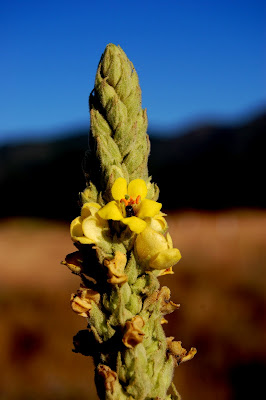




Here are the follow-up photos promised for this morning, but it is already evening. Oh, well. From the top, here are my notes:
The fruit of the manzanita (little apple in Spanish) is a companion to the bear poop posted earlier. A little detective work is always fun. What are the prominent berry-like particles in the bear poop? without getting too messy, just pick one or two berries out with a stick or knife blade. Then, cut them in half and observe - is there a single pit or stone, or several seeds, or...? Then, in the vicinity of the poop, what berry-like ovaries are abundant? In this case, it was manzanita and wild cherries - either Choke Cherry or Bitter Cherry. Case closed. Our bear was eating lots of manzanita. While my photo of bear poop was taken near the Oakland Camp, I walked down Coburn Street later Sunday afternoon and there was fresh bear poop in the middle of the street - still steaming, as one of my campers would say. Apparently not afraid to come into town. Sunday a week ago, many people in this neighborhood put their trash cans out in the evening for the Monday morning pickup. Monday morning there were tipped over can and ripped open bags of trash up and down the street. Duh!!!
The next two photos I took along the railroad track above Oakland Camp. Intriguing because the Purple Milkweed in and around camp as well as along Highways 70 and 89 were all pretty healthy looking and were now producing their seed pods. This particular specimen was probably stressed in some manner and was covered with such a dense colony of aphids that there literally a big puddle of aphid secretions on the ground beneath the plant. Beautiful photos? Not in conventional terms. But, in terms of my earlier hypothesis - interesting = beautiful - they were quite satisfying. When I saw the dense cluster of aphids, I looked in vain for the ants that often herd them.
Then, the Pennyroyal. Down at camp, along the roads in both directions, the Pennyroyal had gone to seed a few weeks ago, but here was a lone specimen by the railroad tracks still in full bloom and full fragrance. Beautiful, but why was it still blooming? The immediate surroundings seemed hotter and drier than the habitats below where the others had gone to seed. Again, I come away from a walk with more questions than answers.
Last, the Snowy Thistle, one bloom and one cluster gone to seed. A pretty plant. Many specimens in the vicinity had huge clusters of ants on them. I choose to post this photo because I thought my readers might be tired of bugs and ugly stuff.


 Some attractive yellow flowers just outside the county jail. I wonder if they look as nice from the other side of the fence. Brought back memories of Chekhov's "The Bet."
Some attractive yellow flowers just outside the county jail. I wonder if they look as nice from the other side of the fence. Brought back memories of Chekhov's "The Bet."

























 Here are the follow-up photos promised for this morning, but it is already evening. Oh, well. From the top, here are my notes:
Here are the follow-up photos promised for this morning, but it is already evening. Oh, well. From the top, here are my notes:
















 My friend has the longest driveway I know of around Quincy. At this time of year, it's mostly lined with dead grass. That can be beautiful, especially when seen up close in early morning light, or when romanticized as "amber waves of grain." However, while driving along, one notices little spots of yellow and blue, and occasional white and pink. I got out and walked and discovered the beautiful array of wildflowers shown here as well as some great patches of lichens growing on the barn. For close-up views and captions, click on any photo.
My friend has the longest driveway I know of around Quincy. At this time of year, it's mostly lined with dead grass. That can be beautiful, especially when seen up close in early morning light, or when romanticized as "amber waves of grain." However, while driving along, one notices little spots of yellow and blue, and occasional white and pink. I got out and walked and discovered the beautiful array of wildflowers shown here as well as some great patches of lichens growing on the barn. For close-up views and captions, click on any photo.